Synthesis of Ge1?xSnx Alloy Thin Films by Rapid Thermal Annealing of Sputtered Ge/Sn/Ge Layers on Si Substrates
Abstract
:1. Introduction
2. Materials and Methods
3. Results and Discussion
4. Conclusions
Author Contributions
Funding
Acknowledgments
Conflicts of Interest
References
- Fan, Q.; Chai, C.; Wei, Q.; Zhou, P.; Yang, Y. Two novel Ge phases and their SiGe alloys with excellent electronic and optical properties. Mater. Des. 2017, 132, 539–551. [Google Scholar] [CrossRef]
- Douglas, J.P. Si/SiGe heterostructures: From material and physics to devices and circuits. Semicond. Sci. Technol. 2004, 19, R75. [Google Scholar]
- Alberi, K.; Blacksberg, J.; Bell, L.D.; Nikzad, S.; Yu, K.M.; Dubon, O.D.; Walukiewicz, W. Band anticrossing in highly mismatched SnxGe1−x semiconducting alloys. Phys. Rev. B 2008, 77, 073202. [Google Scholar] [CrossRef]
- Yin, W.-J.; Gong, X.-G.; Wei, S.-H. Origin of the unusually large band-gap bowing and the breakdown of the band-edge distribution rule in the SnxGe1−x alloys. Phys. Rev. B 2008, 78, 161203. [Google Scholar] [CrossRef]
- D’Costa, V.R.; Cook, C.S.; Birdwell, A.G.; Littler, C.L.; Canonico, M.; Zollner, S.; Kouvetakis, J.; Menéndez, J. Optical critical points of thin-film G1−ySny alloys: A comparative G1−ySny/Ge1−xSix study. Phys. Rev. B 2006, 73, 125207. [Google Scholar] [CrossRef]
- Chen, R.; Lin, H.; Huo, Y.; Hitzman, C.; Kamins, T.I.; Harris, J.S. Increased photoluminescence of strain-reduced, high-Sn composition Ge1−xSnx alloys grown by molecular beam epitaxy. Appl. Phys. Lett. 2011, 99, 181125. [Google Scholar] [CrossRef]
- Gallagher, J.D.; Senaratne, C.L.; Kouvetakis, J.; Menéndez, J. Compositional dependence of the bowing parameter for the direct and indirect band gaps in Ge1−ySny alloys. Appl. Phys. Lett. 2014, 105, 142102. [Google Scholar] [CrossRef]
- Wirths, S.; Geiger, R.; von den Driesch, N.; Mussler, G.; Stoica, T.; Mantl, S.; Ikonic, Z.; Luysberg, M.; Chiussi, S.; Hartmann, J.M.; et al. Lasing in direct-bandgap GeSn alloy grown on Si. Nat. Photonics 2015, 9, 88–92. [Google Scholar] [CrossRef] [Green Version]
- Du, W.; Hou, Z.; Ghetmiri, S.A.; Mosleh, A.; Conley, B.R.; Nazzal, A.; Soref, R.A.; Sun, G.; Tolle, J.; Margetis, J.; et al. Room-temperature electroluminescence from Ge/Ge1−xSnx/Ge diodes on Si substrates. Appl. Phys. Lett. 2014, 104, 241110. [Google Scholar] [CrossRef]
- Baert, B.; Gupta, S.; Gencarelli, F.; Loo, R.; Simoen, E.; Nguyen, N.D. Electrical characterization of p-GeSn/n-Ge diodes with interface traps under DC and AC regimes. Solid-State Electron. 2015, 110, 65–70. [Google Scholar] [CrossRef]
- Conley, B.R.; Mosleh, A.; Ghetmiri, S.A.; Du, W.; Soref, R.A.; Sun, G.; Margetis, J.; Tolle, J.; Naseem, H.A.; Yu, S.-Q. Temperature dependent spectral response and detectivity of GeSn photoconductors on silicon for short wave infrared detection. Opt. Express 2014, 22, 15639–15652. [Google Scholar] [CrossRef] [PubMed]
- Zheng, J.; Wang, S.; Liu, Z.; Cong, H.; Xue, C.; Li, C.; Zuo, Y.; Cheng, B.; Wang, Q. GeSn p-i-n photodetectors with GeSn layer grown by magnetron sputtering epitaxy. Appl. Phys. Lett. 2016, 108, 033503. [Google Scholar] [CrossRef]
- Thurmond, C.D.; Trumbore, F.A.; Kowalchik, M. Germanium solidus curves. J. Chem. Phys. 1956, 25, 799–800. [Google Scholar] [CrossRef]
- Pukite, P.R.; Harwit, A.; Iyer, S.S. Molecular beam epitaxy of metastable, diamond structure SnxGe1−x alloys. Appl. Phys. Lett. 1989, 54, 2142–2144. [Google Scholar] [CrossRef]
- Wang, W.; Su, S.; Zheng, J.; Zhang, G.; Xue, C.; Zuo, Y.; Cheng, B.; Wang, Q. Flattening of low temperature epitaxial Ge1−xSnx/Ge/Si(100) alloys via mass transport during post-growth annealing. Appl. Surf. Sci. 2011, 257, 4468–4471. [Google Scholar] [CrossRef]
- Nikolenko, A.S.; Strelchuk, V.V.; Safriuk, N.V.; Kryvyi, S.B.; Kladko, V.P.; Oberemok, O.S.; Borkovska, L.V.; Sadofyev, Y.G. Structural and optical studies of strain relaxation in Ge1−xSnx layers grown on Ge/Si(001) by molecular beam epitaxy. Thin Solid Films 2015, 613, 68–74. [Google Scholar] [CrossRef]
- Han, D.; Ye, H.; Song, Y.; Zhu, Z.; Yang, Y.; Yu, Z.; Liu, Y.; Wang, S.; Di, Z. Analysis of Raman scattering from inclined GeSn/Ge dual-nanowire heterostructure on Ge(111) substrate. Appl. Surf. Sci. 2019, 463, 581–586. [Google Scholar] [CrossRef]
- Gencarelli, F.; Shimura, Y.; Kumar, A.; Vincent, B.; Moussa, A.; Vanhaeren, D.; Richard, O.; Bender, H.; Vandervorst, W.; Caymax, M.; et al. Amorphous inclusions during Ge and GeSn epitaxial growth via chemical vapor deposition. Thin Solid Films 2015, 590, 163–169. [Google Scholar] [CrossRef]
- Dufrêne, Y.F.; Rouxhet, P.G. X-ray photoelectron spectroscopy analysis of the surface composition of Azospirillum brasilense in relation to growth conditions. Colloids Surf. B Biointerfaces 1996, 7, 271–279. [Google Scholar] [CrossRef]
- Tsai, C.-E.; Lu, F.-L.; Chen, P.-S.; Liu, C.W. Boron-doping induced Sn loss in GeSn alloys grown by chemical vapor deposition. Thin Solid Films 2018, 660, 263–266. [Google Scholar] [CrossRef]
- Lieten, R.R.; Seo, J.W.; Decoster, S.; Vantomme, A.; Peters, S.; Bustillo, K.C.; Haller, E.E.; Menghini, M.; Locquet, J.P. Tensile strained GeSn on Si by solid phase epitaxy. Appl. Phys. Lett. 2013, 102, 052106. [Google Scholar] [CrossRef]
- Huang, Z.-M.; Huang, W.-Q.; Liu, S.-R.; Dong, T.-G.; Wang, G.; Wu, X.-K.; Qin, C.-J. Emission of direct-gap band in germanium with Ge-GeSn layers on one-dimensional structure. Sci. Rep. 2016, 6, 24802. [Google Scholar] [CrossRef] [PubMed] [Green Version]
- Wang, Y.; Zhang, L.; Huang, Z.; Li, C.; Chen, S.; Huang, W.; Xu, J.; Wang, J. Crystallization of GeSn thin films deposited on Ge(100) substrate by magnetron sputtering. Mater. Sci. Semicond. Process. 2018, 88, 28–34. [Google Scholar] [CrossRef]
- Zheng, J.; Liu, Z.; Zhang, Y.; Zuo, Y.; Li, C.; Xue, C.; Cheng, B.; Wang, Q. Growth of high-Sn content (28%) GeSn alloy films by sputtering epitaxy. J. Cryst. Growth 2018, 492, 29–34. [Google Scholar] [CrossRef]
- Taoka, N.; Sakai, A.; Mochizuki, S.; Nakatsuka, O.; Ogawa, M.; Zaima, S. Control of misfit dislocations in strain-relaxed SiGe buffer layers on SOI substrates. Thin Solid Films 2006, 508, 147–151. [Google Scholar] [CrossRef]
- Takayoshi, S.; Shimpei, O.; Chiaki, Y.; Takuji, H.; Heiji, W. Fabrication of fully relaxed SiGe layers with high Ge concentration on silicon-on-insulator wafers by rapid melt growth. Appl. Phys. Express 2010, 3, 105501. [Google Scholar]
- Nakaharai, S.; Tezuka, T.; Sugiyama, N.; Moriyama, Y.; Takagi, S.I. Characterization of 7-nm-thick strained Ge-on-insulator layer fabricated by Ge-condensation technique. Appl. Phys. Lett. 2003, 83, 3516–3518. [Google Scholar] [CrossRef]
- Hirofumi, F.; Hiroaki, M.; Toshio, N.; Takeshi, I.; Yukio, O. Structural changes of amorphous Ge1−xSnx alloy films by annealing. Jpn. J. Appl. Phys. 1986, 25, 1312. [Google Scholar]
- Castain, J. Hand Book of X-ray Photoelectron Spectroscopy; Perkin-Elmer Corp.: Minnisota, MN, USA, 1992. [Google Scholar]
- Li, H.; Brouillet, J.; Salas, A.; Wang, X.; Liu, J. Low temperature growth of high crystallinity GeSn on amorphous layers for advancedoptoelectronics. Opt. Mater. Express 2013, 3, 1385–1396. [Google Scholar] [CrossRef]
- Ramadoss, A.; Krishnamoorthy, K.; Kim, S.J. Facile synthesis of hafnium oxide nanoparticles via precipitation method. Mater. Lett. 2012, 75, 215–217. [Google Scholar] [CrossRef]
- Yoichi, K.; Takaaki, S.; Shinji, K. Temperature dependence of mobility in silicon (100) inversion layers at low temperatures. Surf. Sci. 1982, 113, 218–222. [Google Scholar] [CrossRef]
- Vegard, L. Die Konstitution der Mischkristalle und die Raumfüllung der Atome. Z. Phys. 1921, 5, 17–26. [Google Scholar] [CrossRef]
- Gencarelli, F.; Vincent, B.; Demeulemeester, J.; Vantomme, A.; Moussa, A.; Franquet, A.; Kumar, A.; Bender, H.; Meersschaut, J.; Vandervorst, W.; et al. Crystalline properties and strain relaxation mechanism of CVD grown GeSn. ECS Trans. 2013, 50, 875–883. [Google Scholar] [CrossRef]
- Conley, B.R.; Mosleh, A.; Ghetmiri, S.A.; Du, W.; Sun, G.; Soref, R.; Margetis, J.; Tolle, J.; Naseem, H.A.; Yu, S.-Q. Stability of pseudomorphic and compressively strained Ge1-xSnx thin films under rapid thermal annealing. ECS Trans. 2014, 64, 881–893. [Google Scholar] [CrossRef]
- D’Costa, V.R.; Tolle, J.; Poweleit, C.D.; Kouvetakis, J.; Menéndez, J. Compositional dependence of Raman frequencies in ternary Ge1−x−ySixSny alloys. Phys. Rev. B 2007, 76, 035211. [Google Scholar] [CrossRef]
- D’Costa, V.R.; Tolle, J.; Roucka, R.; Poweleit, C.D.; Kouvetakis, J.; Menéndez, J. Raman scattering in Ge1−ySny alloys. Solid State Commun. 2007, 144, 240–244. [Google Scholar] [CrossRef]
- Oehme, M.; Buca, D.; Kostecki, K.; Wirths, S.; Holländer, B.; Kasper, E.; Schulze, J. Epitaxial growth of highly compressively strained GeSn alloys up to 12.5% Sn. J. Cryst. Growth 2013, 384, 71–76. [Google Scholar] [CrossRef]
- Fournier-Lupien, J.-H.; Mukherjee, S.; Wirths, S.; Pippel, E.; Hayazawa, N.; Mussler, G.; Hartmann, J.M.; Desjardins, P.; Buca, D.; Moutanabbir, O. Strain and composition effects on Raman vibrational modes of silicon-germanium-tin ternary alloys. Appl. Phys. Lett. 2013, 103, 263103. [Google Scholar] [CrossRef]
- Tsao, C.-Y.; Weber, J.W.; Campbell, P.; Conibeer, G.; Song, D.; Green, M.A. In situ low temperature growth of poly-crystalline germanium thin film on glass by RF magnetron sputtering. Sol. Energy Mater. Sol. Cells 2010, 94, 1501–1505. [Google Scholar] [CrossRef]
- Tsao, C.-Y.; Weber, J.W.; Campbell, P.; Widenborg, P.I.; Song, D.; Green, M.A. Low-temperature growth of polycrystalline Ge thin film on glass by in situ deposition and ex situ solid-phase crystallization for photovoltaic applications. Appl. Surf. Sci. 2009, 255, 7028–7035. [Google Scholar] [CrossRef]
- Li, S.F.; Bauer, M.R.; Menéndez, J.; Kouvetakis, J. Scaling law for the compositional dependence of Raman frequencies in SnGe and GeSi alloys. Appl. Phys. Lett. 2004, 84, 867–869. [Google Scholar] [CrossRef]
- Rojas-López, M.; Navarro-Contreras, H.; Desjardins, P.; Gurdal, O.; Taylor, N.; Carlsson, J.R.A.; Greene, J.E. Raman scattering from fully strained Ge1−xSnx (x < 0.22) alloys grown on Ge(001)2 × 1 by low-temperature molecular beam epitaxy. J. Appl. Phys. 1998, 84, 2219–2223. [Google Scholar] [CrossRef]
- Su, S.; Wang, W.; Cheng, B.; Hu, W.; Zhang, G.; Xue, C.; Zuo, Y.; Wang, Q. The contributions of composition and strain to the phonon shift in Ge1-xSnx alloys. Solid State Commun. 2011, 151, 647–650. [Google Scholar] [CrossRef]
- Nakatsuka, O.; Mochizuki, K.; Shimura, Y.; Yamaha, T.; Zaima, S. Low temperature formation of Si1−x−yGexSny on insulator structures by using solid-phase mixing of Ge1−zSnz/Si on insulator substrates. Thin Solid Films 2012, 520, 3288–3292. [Google Scholar] [CrossRef]
- Okugawa, M.; Nakamura, R.; Ishimaru, M.; Yasuda, H.; Numakura, H. Thermal crystallization of sputter-deposited amorphous Ge films: Competition of diamond cubic and hexagonal phases. AIP Adv. 2016, 6, 125035. [Google Scholar] [CrossRef] [Green Version]
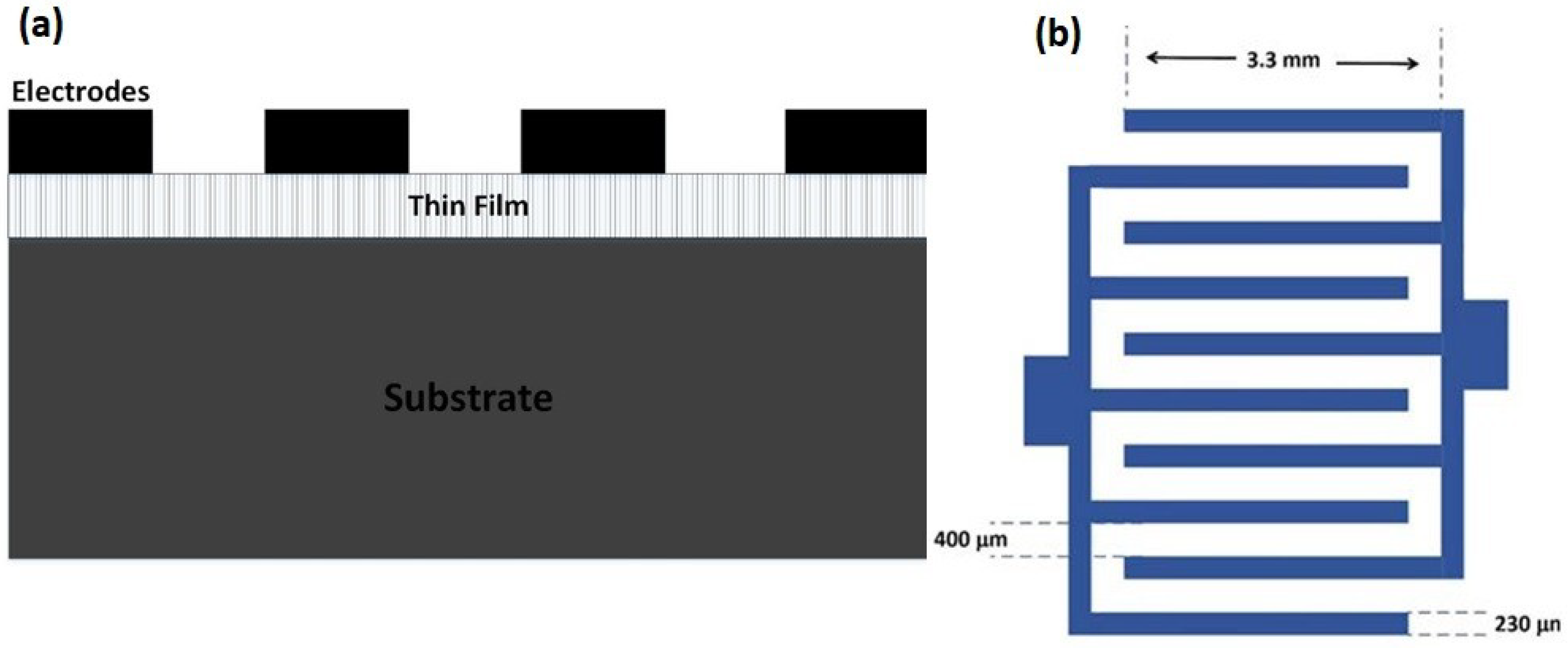
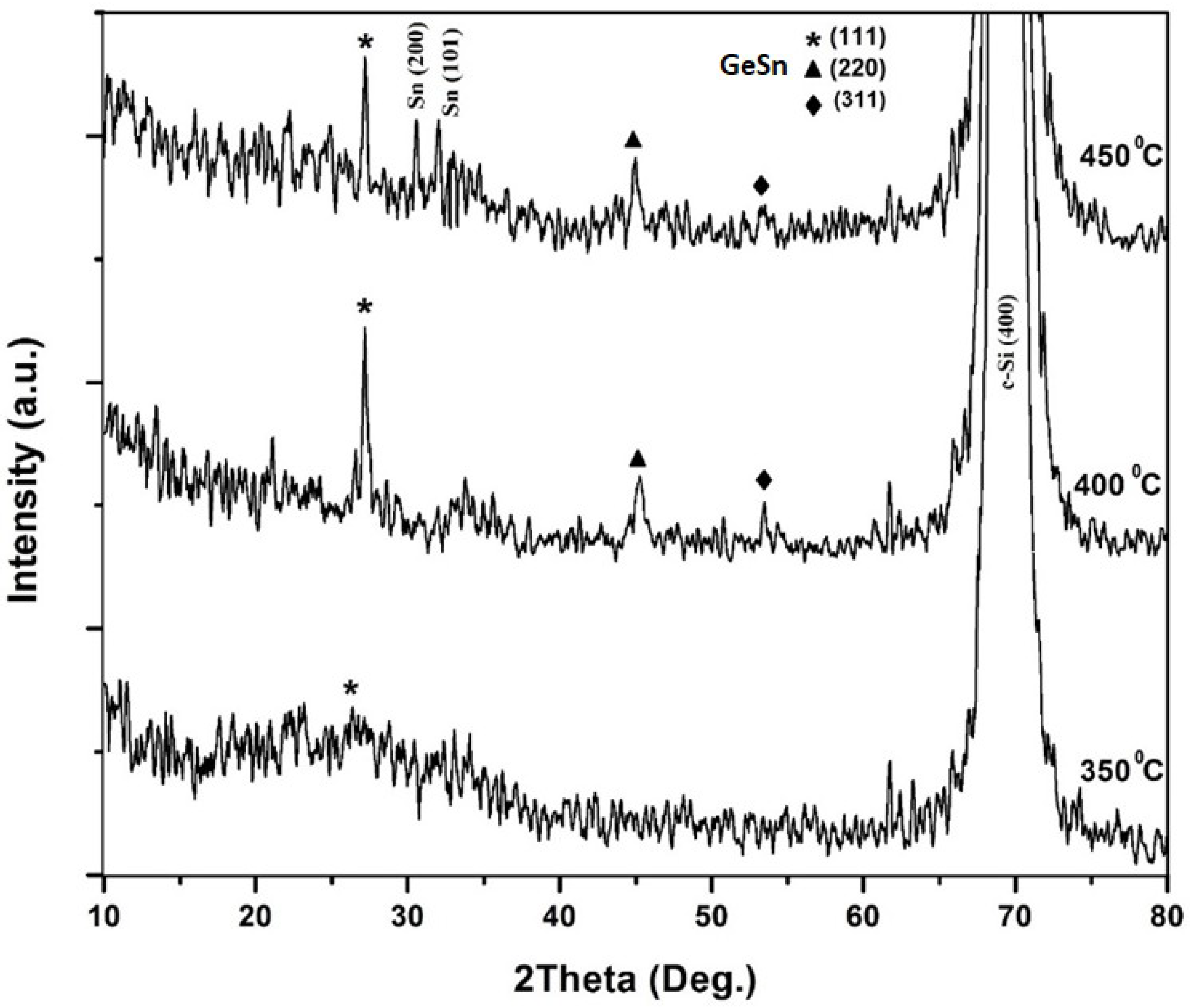

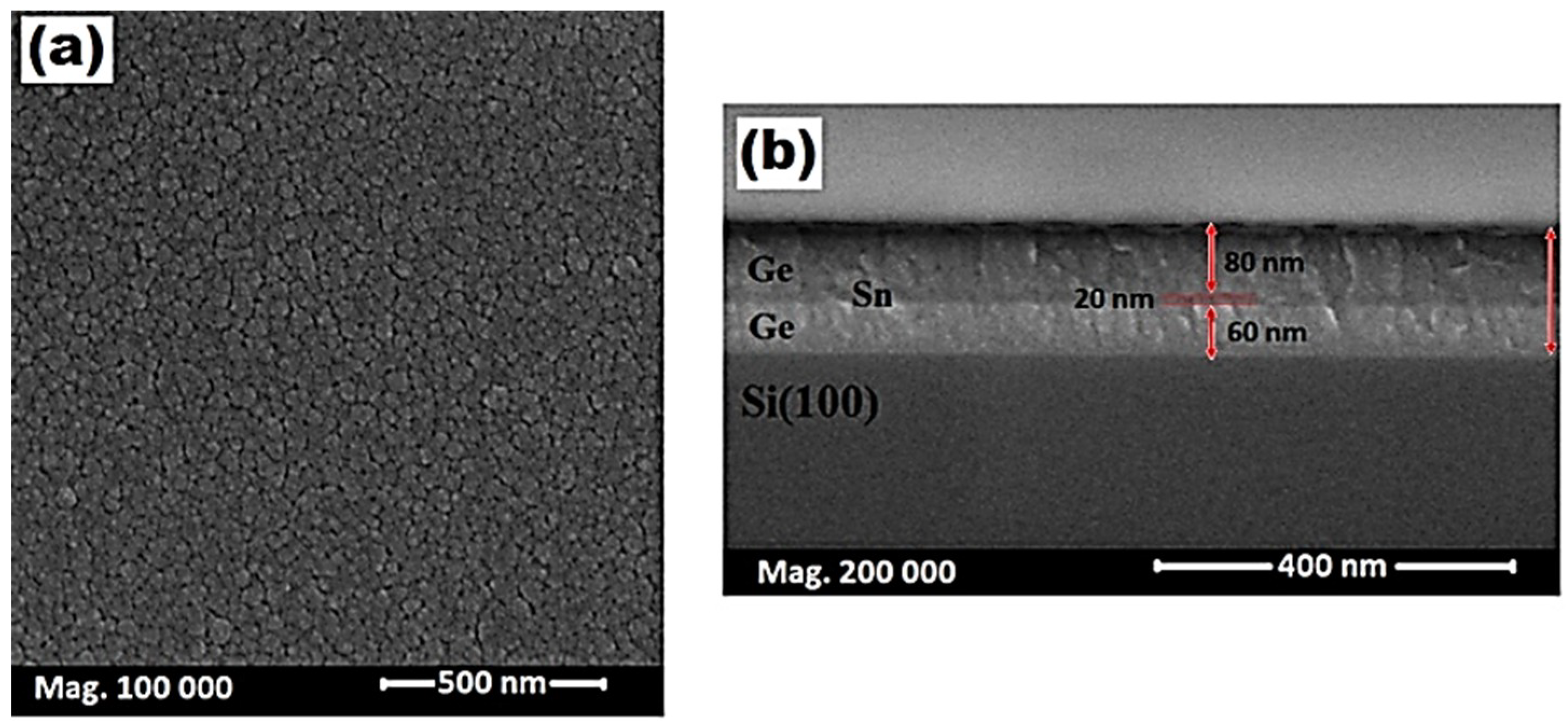
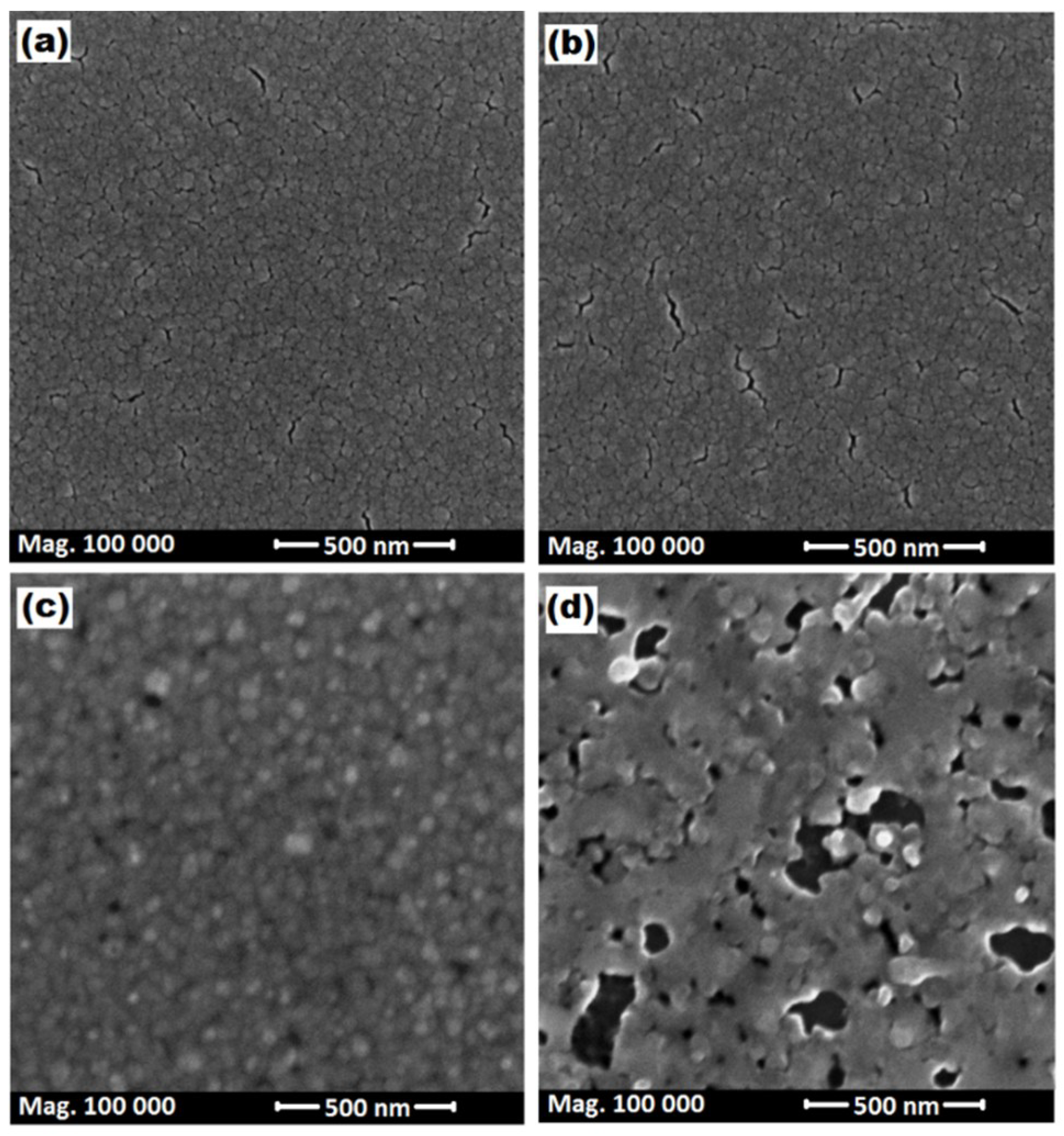

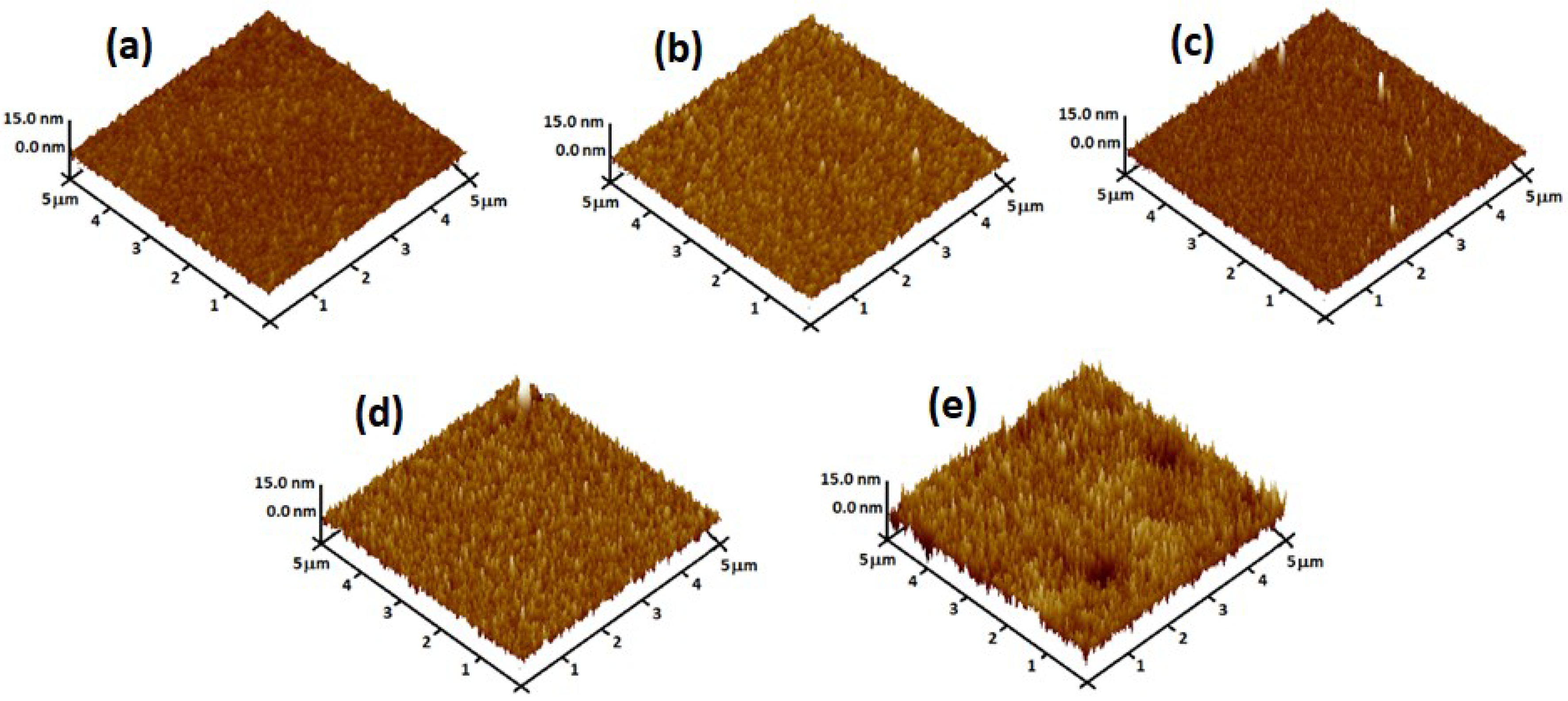
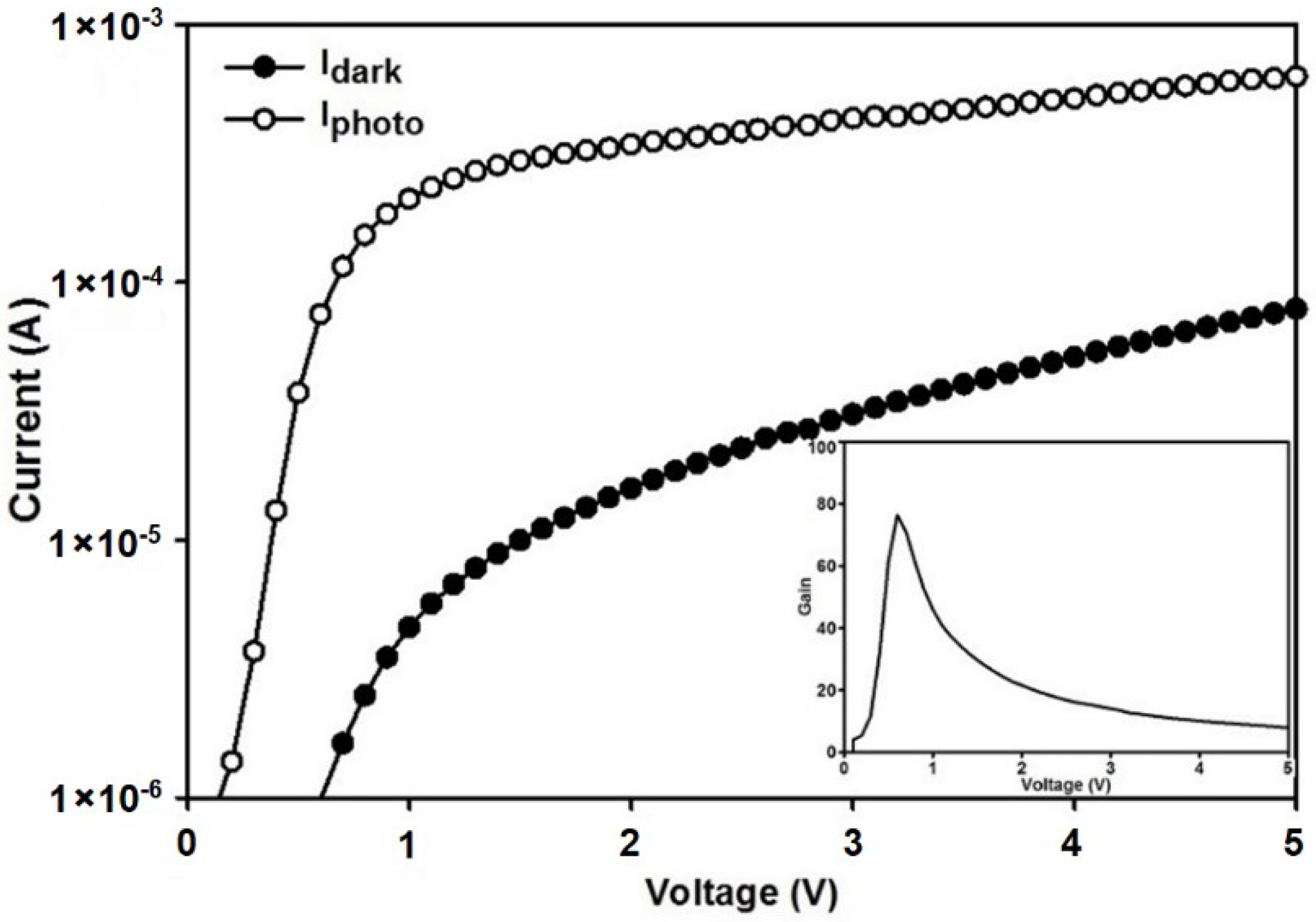
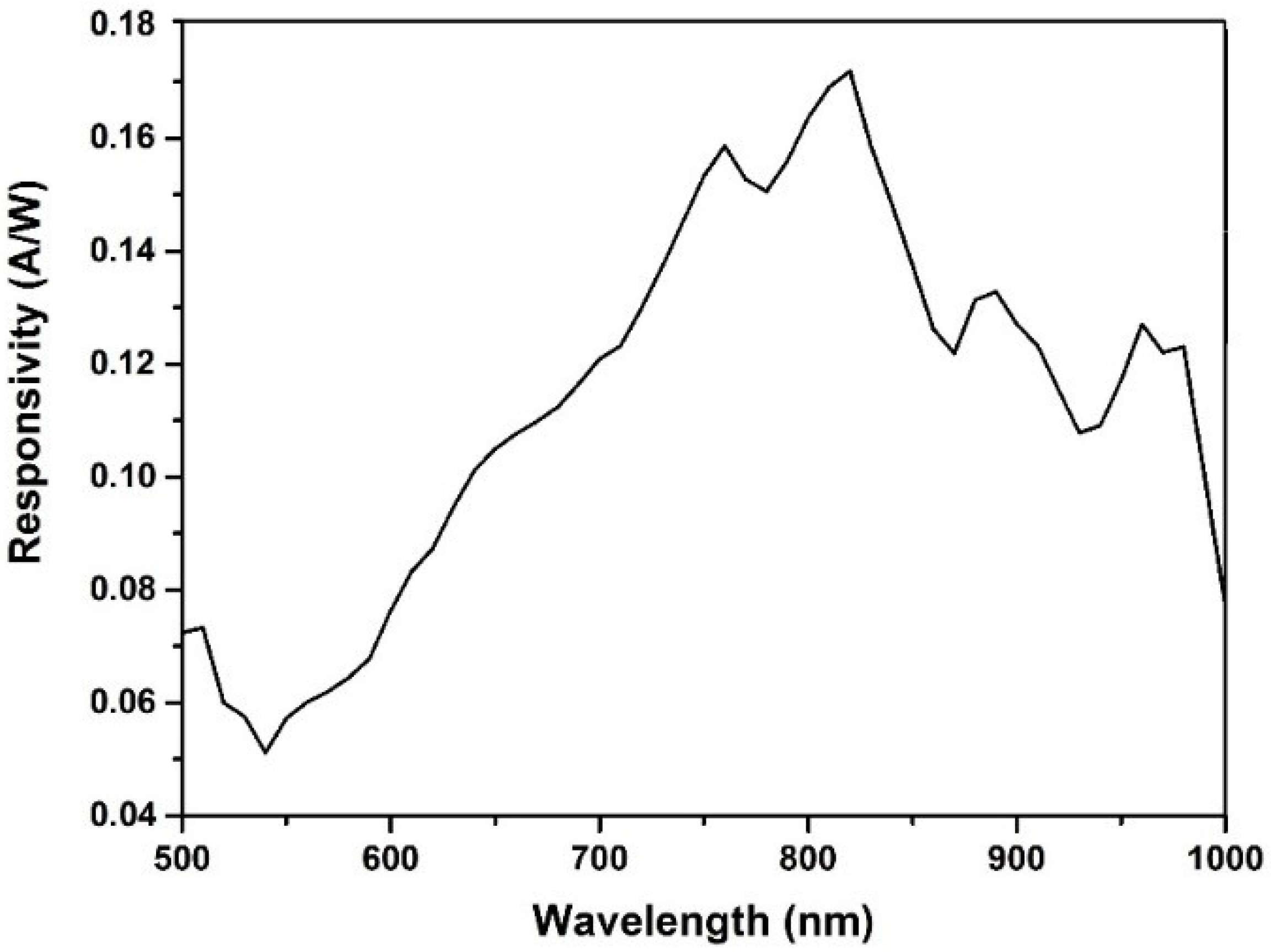
| Sample | Orientation | 2θ (Deg.) | FWHM (Deg.) | Crystalline Size (nm) | Sn Composition (%) |
|---|---|---|---|---|---|
| 400 °C | (111) | 27.16 | 0.4208 | 20.30 | 2.7 |
| (220) | 45.20 | 0.9012 | 9.97 | ||
| 450 °C | (111) | 27.22 | 0.3653 | 23.38 | 1.5 |
| (220) | 45.25 | 0.5963 | 15.05 |
| Samples | Ge-Ge (cm−1) | Peak Intensity (a.u.) | FWHM (cm−1) | Raman Shift * (cm−1) | Raman Shift (cm−1) | WL/WR |
|---|---|---|---|---|---|---|
| As-grown | 276.32 | 661.00 | 45 | 24.71 | - | - |
| 300 °C | 274.78 | 621.611 | 42 | 26.25 | - | - |
| 350 °C | 274.62 | 659.833 | 35 | 26.41 | - | - |
| 400 °C | 294.39 | 1773.83 | 12.76 | 6.64 | 18.07 | 3.231 |
| 450 °C | 296.60 | 1719.00 | 8.29 | 4.43 | 20.28 | 1.274 |
| Samples | As-Sputtered | 300 °C | 350 °C | 400 °C | 450 °C |
|---|---|---|---|---|---|
| Surface Roughness (nm) | 1.02 | 1.18 | 1.2 | 1.77 | 2.85 |
© 2018 by the authors. Licensee MDPI, Basel, Switzerland. This article is an open access article distributed under the terms and conditions of the Creative Commons Attribution (CC BY) license (http://creativecommons.org/licenses/by/4.0/).
Share and Cite
Mahmodi, H.; Hashim, M.R.; Soga, T.; Alrokayan, S.; Khan, H.A.; Rusop, M. Synthesis of Ge1?xSnx Alloy Thin Films by Rapid Thermal Annealing of Sputtered Ge/Sn/Ge Layers on Si Substrates. Materials 2018, 11, 2248. https://doi.org/10.3390/ma11112248
Mahmodi H, Hashim MR, Soga T, Alrokayan S, Khan HA, Rusop M. Synthesis of Ge1?xSnx Alloy Thin Films by Rapid Thermal Annealing of Sputtered Ge/Sn/Ge Layers on Si Substrates. Materials. 2018; 11(11):2248. https://doi.org/10.3390/ma11112248
Chicago/Turabian StyleMahmodi, Hadi, Md Roslan Hashim, Tetsuo Soga, Salman Alrokayan, Haseeb A. Khan, and Mohamad Rusop. 2018. "Synthesis of Ge1?xSnx Alloy Thin Films by Rapid Thermal Annealing of Sputtered Ge/Sn/Ge Layers on Si Substrates" Materials 11, no. 11: 2248. https://doi.org/10.3390/ma11112248
APA StyleMahmodi, H., Hashim, M. R., Soga, T., Alrokayan, S., Khan, H. A., & Rusop, M. (2018). Synthesis of Ge1?xSnx Alloy Thin Films by Rapid Thermal Annealing of Sputtered Ge/Sn/Ge Layers on Si Substrates. Materials, 11(11), 2248. https://doi.org/10.3390/ma11112248





